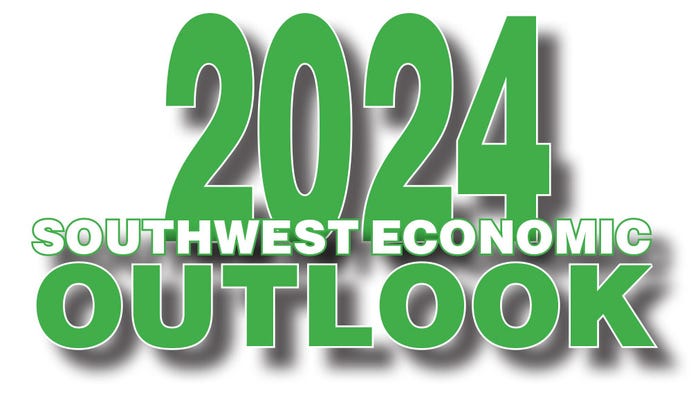
*This is the first article in our 2024 Southwest Economic Outlook series. Hear from Oklahoma State University and OSU Extension Service, and Texas A&M University and TAMU AgriLife Extension Service economists about the 2024 outlook. 
The status of the general U.S. economy plays an important role in the outlook for the agricultural industry. Trends in economic growth and consumer demand influence commodity prices. Interest rates, inflation, and labor markets impact production costs. Agricultural producers face a great deal of uncertainty in any economic environment.
For a while, inflation has been the dominant economic topic. At the close of 2023, there was some indication of easing inflation. Expectations were centered around a Consumer Price Index (CPI) that had leveled to around 3% annually, compared to a high of 9% in mid-2022. When inflation started heating up in 2021, we heard much about rising prices being “transitory,” referring to temporary price changes due to disturbances such as supply shortages. On the other hand, actual inflation refers to a devaluation of currency. Both affect prices, making it difficult to distinguish between the two.
One way to get a handle on the difference is to look at variations of CPI. Core CPI, for example, removes the effects of highly variable food and energy prices. Core CPI in late 2023 was estimated to have settled to a pace of about 4% annually. CPI for services was still running about 5%, reflecting continued shortages in labor markets and wage pressure. While still historically high, housing prices have also steadily declined throughout 2023. The good news is that by most measures, the pace of increasing prices in the general economy is slowing and approaching the 2% Federal Reserve target. The downside is some of those same slowing measures can indicate a pending recession.
With improving inflation estimates, maybe we’ve seen the last of aggressive interest rate hikes. The Federal Funds rate remains at the 5.25%-5.50% range, unchanged since the last increase in July 2023. Most experts anticipate the Fed holding at that level for some time into 2024. Another signal from interest rate markets is the yield curve, specifically the spread between short-term and long-term interest rates. Normally, longer-term investments command a higher rate of return, meaning the curve or relationship between yield and length of investment is positive. For most of 2023, the yield curve has been inverted, with short-term rates running higher than long-term rates. As of mid-December, the 10-year Treasury yield was just under 4.25%, while the 1-year Treasury yield was almost a full percentage point higher at about 5.125%. Historically, an inverted yield curve is one signal of a coming recession. In this case, it seems also to suggest that the market anticipates inflation coming under control. Both can be true, and it may be some version of a mild recession that finally brings inflation in check.
For a couple of years now, the economy has been burning relatively hot with inflation, unprecedented change in labor markets, supply chain disruptions, and extreme variability in many key economic indicators. It brings to mind the scene depicted in the movie “Apollo 13,” where Jim Lovell and crew had to perform a manual burn of the engines to accomplish a course correction. Without the precision of computers and the only measuring stick being the image of the earth in the window, the task was unnerving, chaotic, and imprecise to say the least. The Federal Reserve’s job of managing money supply is similar, though their tasks play out over an extended period of time. The tools at their disposal are a bit clunky, and the economic feedback measures are imprecise. The economy runs in cycles, and, wherever 2024 takes us, there will continue to be talk of a soft landing. That talk suggests that most believe a recession (landing) of some sort is pending.
A dynamic and highly variable general economy can present both challenges and opportunities for agriculture. As we navigate toward that soft landing and maybe more stable economic conditions, the challenge for agriculture is typically in the squeeze of profit margins. Input costs may have stabilized a bit, but they are notoriously sticky and slower to retreat compared to commodity prices. Producers will be pressed to pay close attention to marketing opportunities while strictly managing costs in order to find profits.
About the Author(s)
You May Also Like




